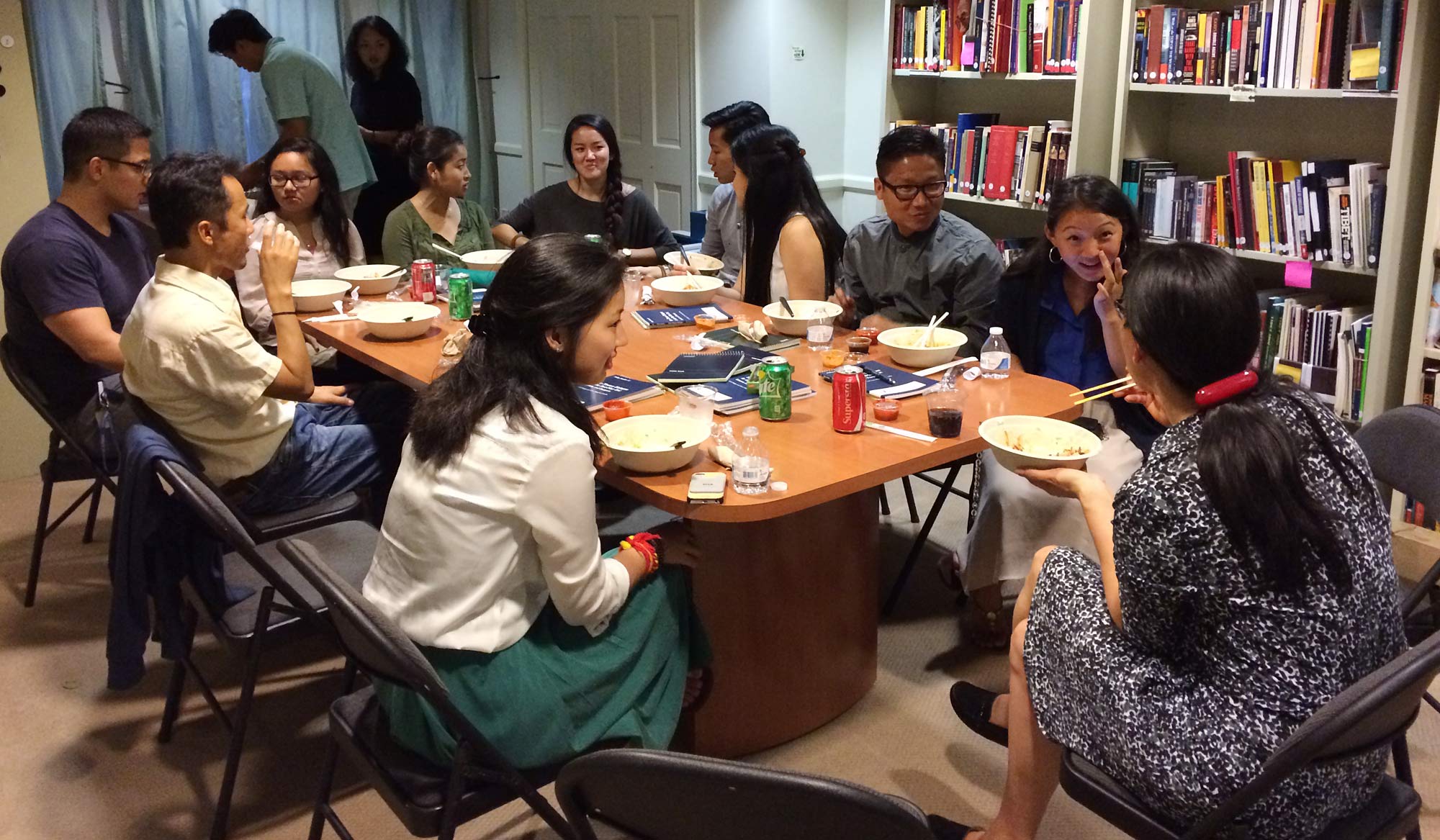By: Pasang Tsering

TYLP participant Pasang Tsering (in glasses) and others getting their orientation from coordinator Tencho Gyatso over dinner on the day of their arrival.
To our utter dismay, the moment we reached Washington, DC, we were greeted with a thunderous shower as if it was following us all the way down from New York. That was hilarious! We Tibetans believe raining while embarking on a new journey is a sign of good luck and a probable success. Now when I look back, I think it might have been a really special symbol. Our seven days in Washington, DC, for Tibetan Youth Leadership Program organized by International Campaign for Tibet (ICT) was in deed special, very special.
Our agenda included visits to the National Endowment for Democracy (NED), Washington Media Institute, Radio Free Asia, Voice of America, Office of Tibet, Congressional Research Service, the House and Senate Offices, and the State Department. We also visited the White House, but that was just for an evening walk. In all seriousness, those aforementioned places where we visited really gave us rare insight and understanding of their significance in American political processes and the Tibetan issues.
Our resource persons for those meetings were NED President Carl Gershman, Chief of VOA Tibetan Service Losang Gyatso, Amos Gelb of the Washington Media Institute, Representative of H.H. the Dalai Lama and Central Tibetan Administration Kaydor Aukatsang, Congressman Jim McGovern and even the U.S. Undersecretary of the State and the Special Coordinator for Tibetan Issues Sarah Sewall.
Similarly, we sat down for series of panel discussions at the ICT office. Our guest speakers included a former Tibetan prime minister, Chinese human rights lawyer, a former Tibetan political prisoner, a motivational speaker, a former State Department senior official, and also ICT president, vice president and director of government relations.
Almost all our training sessions were less formal and more casual. Everyone participated in the discussion as necessary posing questions and adding comments. Just as much as we learned from our resource persons, we learned from each other too in so many ways. Our cohort of 13 attendees ranged from a rising junior to a doctorate candidate and we all had mostly different upbringing and educational and professional background.
For me, the leadership training was special not just because of the places we visited and the people we met and interacted with, but also because of the positive imprints that it instilled in each and every one of us in the process.
Of course, every attendee could have his or her own individual goal for going there, but Bhuchung Tsering, the vice president of ICT, set us a very clear collective goal on the very first day at the orientation. He said, “ICT has overarching goals to achieve from this training, but, in my view, if you can achieve one singular goal, it is more than enough and that goal is to change our mindset.”
Mr. Bhuchung Tsering highlighted the fact that we, Tibetans, identify ourselves as Tibetan refugees or simply Tibetans. Even younger generation who are born and brought up here on American soil consider themselves as Tibetan refugees or may be Tibetans, but not Americans. He stressed, “You are not only Tibetans, you are Tibetan-Americans, too. You are Americans just as everyone else in this country.”
The main reason why he was emphasizing us to recognize this fact was to encourage younger generation to engage ourselves into the civic and cultural life of the American society and be a part of the processes in making a difference here in the country and abroad. Simultaneously, we can help our ancestral land Tibet and Tibetan people through American political, economic and social processes.
This mission of changing our mindset might be a brilliant and doable idea for some, but a daunting challenge for others. We had attendees who were born and brought up here and they are through and through Americans just as they are through and through Tibetans. For them, they might be able to simply fine-tune their narrative. For those who recently immigrated to the United States, including myself, it was a lofty challenge. In fact, it is a constant struggle.
As someone who has a deep appreciation for Buddhist philosophy, I am always mindful of not being carried away by the three sources of evils — attachment, anger and ignorance. Hence, my challenge of finding difficulty in identifying myself as an American is not out of my attachment to my birthplace Nepal or my ancestral land Tibet or obsession with Tibetan pride for that matter, but it was rather my earnest effort in searching the American spirit within my soul deep down inside.
Never in my wildest dream would I dare to identify myself as an American simply because I want to claim rights or pursue personal ends. I would not do it even if the law of the land says I am an American citizen and that I am guaranteed with those inalienable rights for I believe every right comes with duties and one of those sacred duties is to be a genuine American by heart and mind, which can never be determined by one’s place of birth or a piece of paper nor by an accent of speech or color of skin.
To my great joy, another special moment of this training was I found a solace in my search of American spirit. Among many others, Tibetans and Americans have one but the most important thing in common i.e. our values. We are bound by our shared values that treasure life, liberty and pursuit of happiness. That to me is more than enough reason to tie the knot for these two partners once and for all — Tibetan-American!
Mission accomplished. Thank you, ICT!
